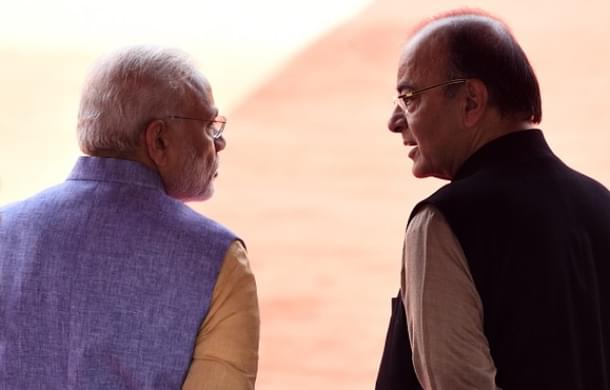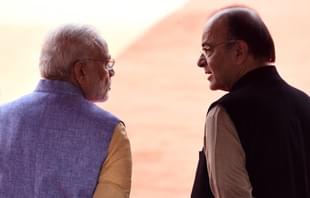Economy
Modi Must Fix Four Flaws At Heart Of GST Mess; We Also Need To Scrap Fiscal Roadmap In 2017-18
R Jagannathan
Nov 11, 2017, 09:58 AM | Updated 09:58 AM IST
Save & read from anywhere!
Bookmark stories for easy access on any device or the Swarajya app.


The GST Council’s decision yesterday (10 November) to shift 178 items from the 28 per cent “non-merit” goods slab to the standard 18 per cent slab, and the announcement that non-star restaurants will now pay 5 per cent flat GST without recourse to input tax credit (ITC), shows the inherent flaws in the “khichdi” that the centre and states agreed to at the outset.
In the short term, perhaps extending for the current and next two quarters, the centre must hold its fiscal targets in abeyance to allow GST to settle into a rhythm where both producers and consumers feel a degree of comfort with the new regime.
The GST’s flaws emanate from four sources: one was the Modi government’s eagerness to say ‘yes’ to all state demands on product-specific taxes and compensation in order to get them to sign on to the GST; two, the decision to seek “revenue-neutrality” without understanding the fundamental economic philosophy underlying any tax reform; three, allowing the bureaucracy to decide how the old rate structure should fit into the new; and four, the central government’s decision to stick to the fiscal roadmap at a time when the economy is sluggish and a major tax reform with unknown consequences is being implemented.
Let’s start with the first flaw. The centre agreed to most state and corporate concerns on commodity-specific rates to get all-round assent for the new tax rates. This is obvious from the fact that some 225-and-odd items were in the top 28 per cent bracket. One cannot see how so many items were considered luxuries or sin goods. Now, only 50 items remain, and that is good.
The centre guaranteed full compensation to states suffering revenue losses, and 14 per cent annual increases. This would certainly have been a factor in putting so many items in the top slab. That we also had a cess over and above this on some goods suggests that genuinely “non-merit” goods were even highly taxed.
The second flaw resulted from the effort to seek revenue-neutrality. Now, revenue-neutrality presumes that you know what the elasticity of demand is for 1,400-and-odd items when that is impossible for babus to calculate reasonably. How, for example, can you know whether putting Gadget A or fur coats in the 28 per cent slab will give you the same revenues as before, or whether the 18 per cent slab will deliver more by generating higher demand for it? You need a busload of micro-economists poring over long-term data and price points and demand in specific items to figure out what the optimal tax rates should be.
The third flaw was bureaucratic. When you ask babus to fix rates on 1,400-and-odd commodities in a matter of weeks, they will simply add up all existing taxes, fit it to the nearest available GST rate, and call that revenue-neutral. This is not considering special pleadings from states or corporate interests on specific items. To add to that, the bureaucratic focus on making the tax system leakproof meant that almost all newcomers to the system were screaming blue murder about high compliance costs.
This is what has been slowly whittled down, with many small businesses now with turnovers of up to Rs 1.5 crore being taxed at flat rates on turnover under the “composition” scheme, and restaurants being shifted to a flat 5 per cent rate, which means they won’t get input tax credits – the fundamental underpinning of any GST system. So, by responding to the protests, the GST Council has essentially left the informal sector out of the rigours of GST compliance in a substantial way.
At some point, when the system settles into a rhythm, this will need to be reversed, or else the whole purpose of GST is gone. If, for example, a restaurant pays 5 per cent without input credits, it means the owner of the premises leased may not have to pay GST, giving landlords a reason to seek payments in cash. The raw materials bought for serving food too may stay out of GST. This is a huge setback to a system that is meant to be self-policing by making the buyer ensure compliance from his input vendors.
The last flaw is central – and relates to tax philosophy. If you are going to stick to the fiscal deficit target when you don’t know how GST will deliver on short-term revenues, your babus will deliver this kind of nonsensical system that needs tweaks all the time. The key principle in tax reform is that short-term outcomes are uncertain; if you want revenue growth, it must come more from increased economic activity generating higher output and hence higher taxes. This takes time, regardless of whether it is an income tax cut or an indirect tax cut. The system must recognise the cut in taxes, these must feed through to lower prices, and consumers must start realising that they can buy more for less. This realisation, which must feed through the supply chain in the case of indirect taxes, will not happen in a matter of one or two quarters.
The above points have two implications:
One, it is foolish to expect revenue buoyancy in the short run when GST is a widespread threat to black money and under-reporting of incomes by informal and small businesses. To top it, various economists and even the Reserve Bank have been talking about GST raising short-term inflation – hardly the right expectation to build about the new taxes.
Two, if the centre has to meet all its compensation promises to states and still cut rates enough to create medium-term revenue buoyancy, it follows that it must relax the fiscal deficit mandate this year and half of next year. You cannot keep rates high, expect full compliance, and still expect demand to not sag and reduce your revenues in the short run.
The right remedy is to relax the fiscal straitjacket for this year and the next few quarters, possibly extending up to mid-2018. Once GST settles, the government will see revenue buoyancy.
Fiscal consolidation does not sit well with the medium-term goal of ensuring higher revenue buoyancy from lower taxes and higher economic activity.
Jagannathan is former Editorial Director, Swarajya. He tweets at @TheJaggi.





